Declaring that the future survival of the International Space Station (ISS) was “jeopardized,” NASA issued a statement late Thursday, Oct. 9, ordering Boeing and SpaceX to restart work to develop commercial crew vehicles under the Commercial Crew Transportation Capability (CCtCap) contracts awarded to each firm on Sept. 16.
NASA took this action despite a protest filed with the U.S. Government Accountability Office (GAO) by the losing commercial crew bidder, Sierra Nevada Corporation.
On Sept. 26, NASA had directed Boeing and SpaceX to “suspend performance of the contracts” in response to the GAO protest filed by Sierra Nevada Corporation.
NASA told Boeing and SpaceX to immediately resume work on their astronaut space taxis under “statutory authority available to NASA.”
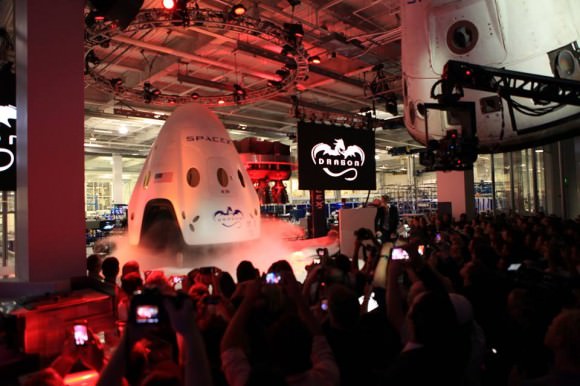
It’s been a wild twist of events ever since NASA Administrator Charles Bolden announced that Boeing and SpaceX had won the high stakes and history making NASA competition to build the first ever private ‘space taxis’ to launch American astronauts to the ISS and restore America’s capability to launch our crews from American soil for the first time since 2011.
Bolden personally made the historic announcement of NASA’s commercial crew contract winners to build America’s next human rated spaceships at the Kennedy Space Center (KSC) on Wednesday, Sept. 16 at a briefing I attended at the press site.
Barely ten days later NASA told Boeing and SpaceX to stop work while the GAO reviews the SNC protest by a Jan 5, 2015, deadline.
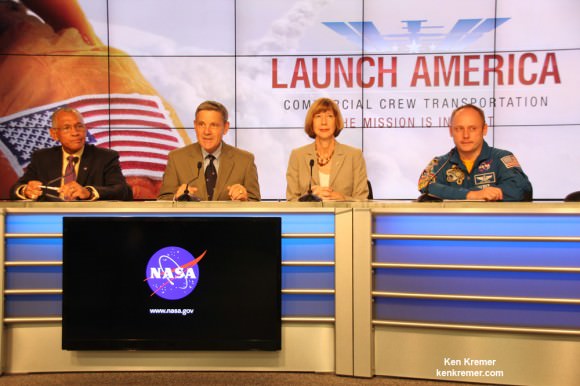
In the meantime, NASA decided that the delay in the commercial crew effort was untenable and posed risks to the ISS, crew operations and U.S. commitments under international agreements.
Therefore NASA exercised its statutory authority to “avoid significant adverse consequences.”
Here is the full text of the NASA’s Oct. 9 statement:
“On Oct. 9, under statutory authority available to it, NASA has decided to proceed with the Commercial Crew Transportation Capability (CCtCap) contracts awarded to The Boeing Company and Space Exploration Technologies Corp. notwithstanding the bid protest filed at the U.S. Government Accountability Office by Sierra Nevada Corporation. The agency recognizes that failure to provide the CCtCap transportation service as soon as possible poses risks to the International Space Station (ISS) crew, jeopardizes continued operation of the ISS, would delay meeting critical crew size requirements, and may result in the U.S. failing to perform the commitments it made in its international agreements. These considerations compelled NASA to use its statutory authority to avoid significant adverse consequences where contract performance remained suspended. NASA has determined that it best serves the United States to continue performance of the CCtCap contracts that will enable safe and reliable travel to and from the ISS from the United States on American spacecraft and end the nation’s sole reliance on Russia for such transportation.”
The ‘space taxi’ contracts to build the Boeing CST-100 and SpaceX Dragon V2 spaceships are worth a total of $6.8 Billion, with the goal to end the nation’s sole source reliance on Russia in 2017.
Boeing was awarded the larger share of the contract valued at $4.2 Billion while SpaceX was awarded a lesser amount valued at $2.6 Billion.
Both spaceships are capsule design with parachute assisted landings. The third competitor involving Sierra Nevada’s Dream Chaser mini-shuttle offering runway landings was not selected for further development.
“From day one, the Obama Administration made clear that the greatest nation on Earth should not be dependent on other nations to get into space,” Bolden told reporters at the agency’s Kennedy Space Center in Florida, on Sept 16.
“Thanks to the leadership of President Obama, the hard work of our NASA and industry teams, and support from Congress, today we are one step closer to launching our astronauts from U.S. soil on American spacecraft and ending the nation’s sole reliance on Russia by 2017. Turning over low-Earth orbit transportation to private industry will also allow NASA to focus on an even more ambitious mission – sending humans to Mars.”
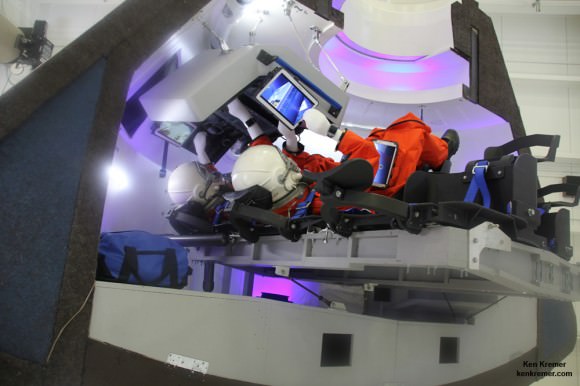
Both the Boeing CST 100 and SpaceX Dragon V2 will launch from the Florida Space Coast, home to all US astronaut flights since the dawn of the space age.
The Boeing CST-100 will launch atop a man rated United Launch Alliance Atlas V rocket from Space Launch Complex 41 on Cape Canaveral Air Force Station, FL.
The SpaceX Dragon will launch atop a man rated Falcon 9 v1.1 rocket from neighboring Space Launch Complex 40 at the Cape.
Stay tuned here for Ken’s continuing Orion and Earth and planetary science and human spaceflight news.
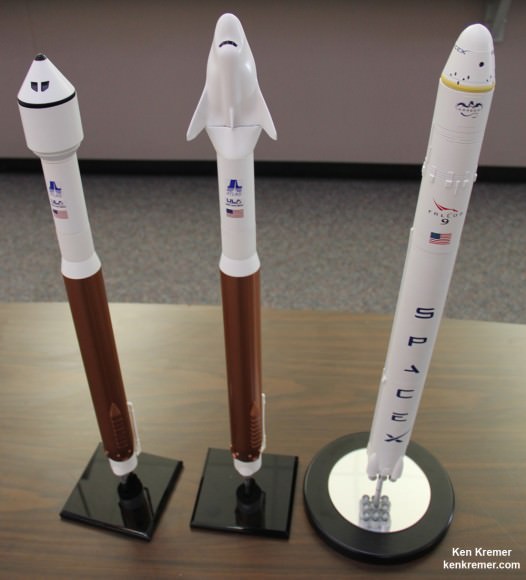
…………….
Learn more about Commercial Space Taxis, Orion and NASA Human and Robotic Spaceflight at Ken’s upcoming presentations
Oct 14: “What’s the Future of America’s Human Spaceflight Program with Orion and Commercial Astronaut Taxis” & “Antares/Cygnus ISS Rocket Launches from Virginia”; Princeton University, Amateur Astronomers Assoc of Princeton (AAAP), Princeton, NJ, 7:30 PM
Oct 23/24: “Antares/Cygnus ISS Rocket Launch from Virginia”; Rodeway Inn, Chincoteague, VA

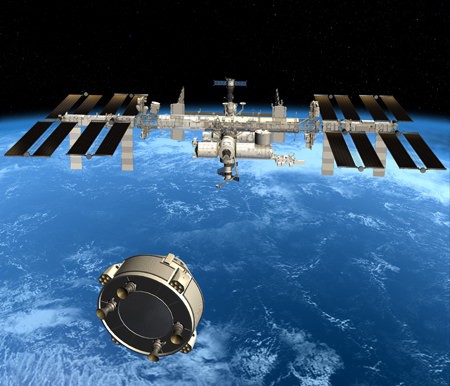
I can’t help thinking that NASA has brought this dilemma on itself. Its reasoning behind its choices still have not been made public. I myself cannot understand why Boeing got such a large piece of the pie. Since it doesn’t even have a rocket engin. Perhaps that is why they need more money. Space X already has a proven rocket engine that only needs to be made safe for human flight. NASA would do itself a favor by clarifying its position on choices and reasoning for them. It will be interesting to see what the GAO findings will be, unless they get buried in the bureaucracy.